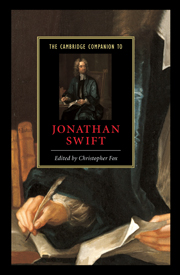Book contents
- Frontmatter
- Introduction
- 1 Swift’s life
- 2 Politics and history
- 3 Swift the Irishman
- 4 Swift’s reading
- 5 Swift and women
- 6 Swift’s satire and parody
- 7 Swift on money and economics
- 8 Language and style
- 9 Swift and religion
- 10 Swift the poet
- 11 A Tale of a Tub and early prose
- 12 Gulliver’sTravels and the later writings
- 13 Classic Swift
- Bibliography
- Index
Introduction
Published online by Cambridge University Press: 28 May 2006
- Frontmatter
- Introduction
- 1 Swift’s life
- 2 Politics and history
- 3 Swift the Irishman
- 4 Swift’s reading
- 5 Swift and women
- 6 Swift’s satire and parody
- 7 Swift on money and economics
- 8 Language and style
- 9 Swift and religion
- 10 Swift the poet
- 11 A Tale of a Tub and early prose
- 12 Gulliver’sTravels and the later writings
- 13 Classic Swift
- Bibliography
- Index
Summary
“When a true Genius appears in the World,” Swift wrote, “you may know him by this infallible Sign; that the Dunces are all in Confederacy against him” (PW i: 242). He may well have been speaking about himself. After his death, his ghost was said to haunt the aisles of St. Patrick's Cathedral in Dublin, complaining that “The Pamphlets wrote against me, would have form'd a Library.” Jonathan Swift (1667-1745) lived a contentious life in a contentious age.
- Type
- Chapter
- Information
- The Cambridge Companion to Jonathan Swift , pp. 1 - 13Publisher: Cambridge University PressPrint publication year: 2003
- 3
- Cited by

